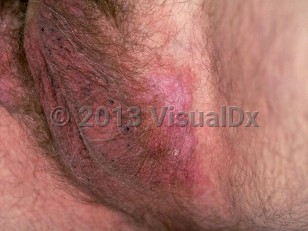Extramammary Paget disease - Anogenital in
See also in: OverviewAlerts and Notices
Important News & Links
Synopsis

Extramammary Paget disease (EMPD) is a rare neoplastic condition that usually occurs in the sixth to eighth decades of life. EMPD may be primary and arise as an adenocarcinoma, or it may be secondary due to spread of a neoplasm. Primary EMPD is thought to be a disorder of apocrine gland-bearing skin. Secondary EMPD may be due to extension of an adnexal adenocarcinoma or due to an underlying malignancy. EMPD may invade and metastasize via lymphatics. The most commonly associated visceral malignancies are anorectal, urothelial, and prostate.
Men are less frequently diagnosed with EMPD than women, except in Japan where there is a male preponderance.
EMPD most frequently presents in men on the penoscrotal or truncal region. Lesions are often banal in appearance and similar to eczema, leading to delays in diagnosis. Symptoms may be minimal to none; often, there is itch, pain, or burning. Presentation is typically of a red, sharply-demarcated plaque that expands slowly. Areas within the plaque are marked by erosions and white scale, leading to the appearance of "strawberries and cream."
Approximately 10% of patients with a new diagnosis of EMPD are diagnosed with a noncontiguous associated malignancy within 12 months of diagnosis. An additional 10%-25% of patients have a contiguous malignancy at the time of diagnosis. The most commonly associated malignancies in men are cancers of the prostate, urinary tract, and rectum. Due to these associations, a thorough investigation for underlying malignancy should accompany every diagnosis. The site involved predicts the site of secondary malignancy. For example, scrotal, anal, and colorectal disease shows an increased risk of scrotal, anal, and colorectal malignancy, respectively.
Men are less frequently diagnosed with EMPD than women, except in Japan where there is a male preponderance.
EMPD most frequently presents in men on the penoscrotal or truncal region. Lesions are often banal in appearance and similar to eczema, leading to delays in diagnosis. Symptoms may be minimal to none; often, there is itch, pain, or burning. Presentation is typically of a red, sharply-demarcated plaque that expands slowly. Areas within the plaque are marked by erosions and white scale, leading to the appearance of "strawberries and cream."
Approximately 10% of patients with a new diagnosis of EMPD are diagnosed with a noncontiguous associated malignancy within 12 months of diagnosis. An additional 10%-25% of patients have a contiguous malignancy at the time of diagnosis. The most commonly associated malignancies in men are cancers of the prostate, urinary tract, and rectum. Due to these associations, a thorough investigation for underlying malignancy should accompany every diagnosis. The site involved predicts the site of secondary malignancy. For example, scrotal, anal, and colorectal disease shows an increased risk of scrotal, anal, and colorectal malignancy, respectively.
Codes
ICD10CM:
C44.99 – Other specified malignant neoplasm of skin, unspecified
SNOMEDCT:
254727007 – Extramammary Paget's disease of skin
C44.99 – Other specified malignant neoplasm of skin, unspecified
SNOMEDCT:
254727007 – Extramammary Paget's disease of skin
Look For
Subscription Required
Diagnostic Pearls
Subscription Required
Differential Diagnosis & Pitfalls

To perform a comparison, select diagnoses from the classic differential
Subscription Required
Best Tests
Subscription Required
Management Pearls
Subscription Required
Therapy
Subscription Required
References
Subscription Required
Last Reviewed:10/13/2024
Last Updated:10/14/2024
Last Updated:10/14/2024
Extramammary Paget disease - Anogenital in
See also in: Overview

